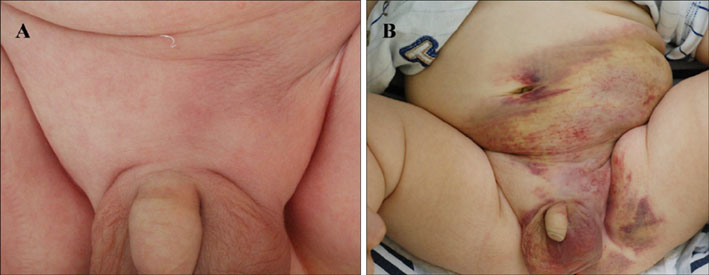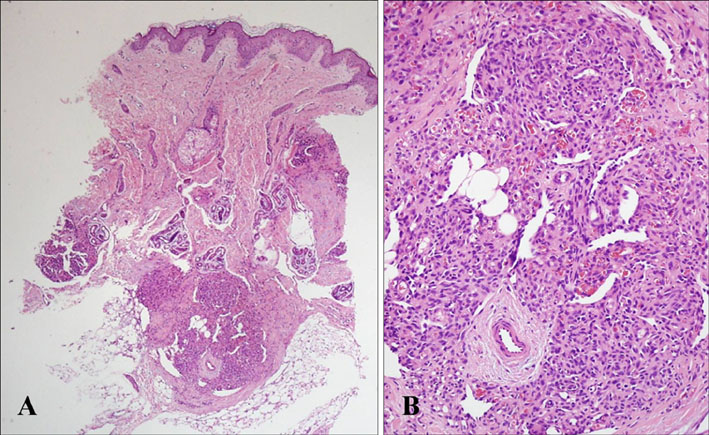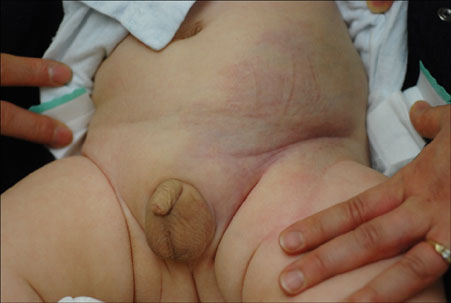Ann Dermatol.
2010 Nov;22(4):426-430. 10.5021/ad.2010.22.4.426.
Kasabach-Merritt Syndrome Arising from Tufted Angioma Successfully Treated with Systemic Corticosteroid
- Affiliations
-
- 1Department of Dermatology & Cutaneous Biology Research Institute, Yonsei University College of Medicine, Seoul, Korea. kychung@yuhs.ac
- KMID: 2266180
- DOI: http://doi.org/10.5021/ad.2010.22.4.426
Abstract
- We report a case of Kasabach-Merritt syndrome arising from a tufted angioma successfully treated with systemic corticosteroid. A 2-month-old male infant presented with a palm-sized, erythematous induration on his left pubis. The lesion was diagnosed as tufted angioma histopathologically. After 1 month, the lesion suddenly expanded to the abdomen and scrotum. Initial laboratory tests were consistent with consumptive coagulopathy. He was diagnosed with Kasabach-Merritt syndrome and treated with intravenous dexamethasone at 0.32 mg/kg/day (equivalent to prednisolone 2.0 mg/kg/day). Two days after initiating the treatment, his platelet counts recovered and the lesion ceased to expand. Steroid therapy was converted to oral prednisolone and the dosage was subsequently tapered, and the lesion gradually involuted with no signs of recurrence for a year.
MeSH Terms
Figure
Cited by 1 articles
-
Intractable Tufted Angioma Associated with Kasabach-Merritt Syndrome
Jae Woo Choi, Jung Im Na, Jong Soo Hong, Soon Hyo Kwon, Sang Young Byun, Kwang Hyun Cho, Sang Woong Youn, Hyung Soo Choi, Kyoung-Duk Park, Kyoung Chan Park
Ann Dermatol. 2013;25(1):129-130. doi: 10.5021/ad.2013.25.1.129.
Reference
-
1. Kasabach HH, Merritt KK. Capillary hemangioma with extensive purpura: report of a case. Am J Dis Child. 1940. 59:1063–1070.2. Alvarez-Mendoza A, Lourdes TS, Ridaura-Sanz C, Ruiz-Maldonado R. Histopathology of vascular lesions found in Kasabach-Merritt syndrome: review based on 13 cases. Pediatr Dev Pathol. 2000. 3:556–560.
Article3. Kim SH, Choi JH, Sung KJ, Moon KC, Koh JK. Clinical and histopathologic study on tufted angioma. Korean J Dermatol. 2000. 38:72–78.4. Ishikawa K, Hatano Y, Ichikawa H, Hashimoto H, Fujiwara S. The spontaneous regression of tufted angioma. A case of regression after two recurrences and a review of 27 cases reported in the literature. Dermatology. 2005. 210:346–348.5. Hesselmann S, Micke O, Marquardt T, Baas S, Bramswig JH, Harms E, et al. Case report: Kasabach-Merritt syndrome: a review of the therapeutic options and a case report of successful treatment with radiotherapy and interferon alpha. Br J Radiol. 2002. 75:180–184.
Article6. Shin HY, Ryu KH, Ahn HS. Stepwise multimodal approach in the treatment of Kasabach-Merritt syndrome. Pediatr Int. 2000. 42:620–624.
Article7. Wananukul S, Nuchprayoon I, Seksarn P. Treatment of Kasabach-Merritt syndrome: a stepwise regimen of prednisolone, dipyridamole, and interferon. Int J Dermatol. 2003. 42:741–748.
Article8. Rodriguez V, Lee A, Witman PM, Anderson PA. Kasabach-merritt phenomenon: case series and retrospective review of the mayo clinic experience. J Pediatr Hematol Oncol. 2009. 31:522–526.9. Martins AG. Hemangioma and thrombocytopenia. J Pediatr Surg. 1970. 5:641–648.
Article10. Enjolras O, Mulliken JB, Wassef M, Frieden IJ, Rieu PN, Burrows PE, et al. Residual lesions after Kasabach-Merritt phenomenon in 41 patients. J Am Acad Dermatol. 2000. 42:225–235.11. Chu CY, Hsiao CH, Chiu HC. Transformation between Kaposiform hemangioendothelioma and tufted angioma. Dermatology. 2003. 206:334–337.
Article12. Esterly NB. Kasabach-Merritt syndrome in infants. J Am Acad Dermatol. 1983. 8:504–513.
Article13. Karaböcüoğlu M, Başarer N, Aydoğan U, Demirkol M, Kurdoğlu G, Neyzi O. Development of Kasabach-Merritt syndrome following needle aspiration of a hemangioma. Pediatr Emerg Care. 1992. 8:218–220.
Article14. Jona JZ, Kwaan HC, Bjelan M, Raffensperger JG. Disseminated intravascular coagulation after excision of giant hemangioma. Am J Surg. 1974. 127:588–592.
Article15. Hall GW. Kasabach-Merritt syndrome: pathogenesis and management. Br J Haematol. 2001. 112:851–862.
Article16. Enjolras O, Riche MC, Merland JJ, Escande JP. Management of alarming hemangiomas in infancy: a review of 25 cases. Pediatrics. 1990. 85:491–498.
Article17. Sadan N, Wolach B. Treatment of hemangiomas of infants with high doses of prednisone. J Pediatr. 1996. 128:141–146.
Article18. Ozsoylu S, Irken G, Gurgey A. High dose intravenous methylprednisolone for Kassabach-Merritt syndrome. Eur J Pediatr. 1989. 148:403–405.
Article19. Uysal KM, Olgun N, Erbay A, Sarialioğlu F. High-dose oral methylprednisolone therapy in childhood hemangiomas. Pediatr Hematol Oncol. 2001. 18:335–341.
Article




